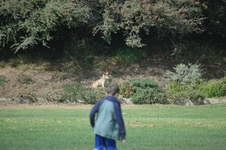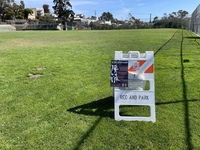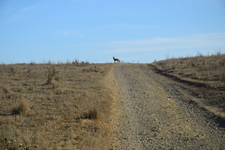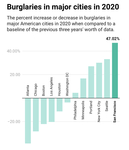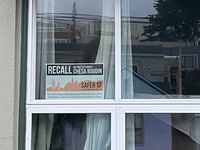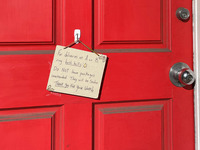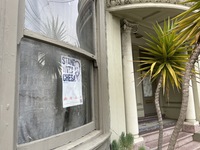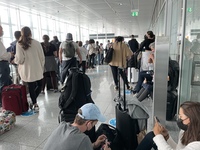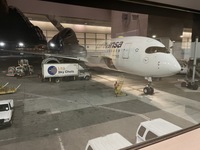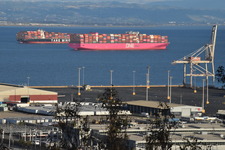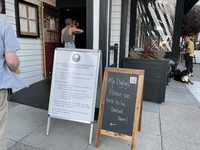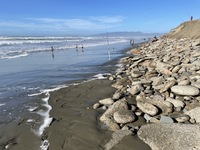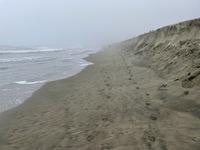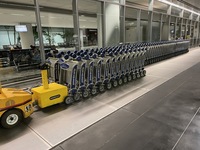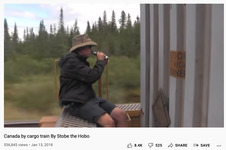 |
| Angelika/Mike Schilli |
Michael We have plenty of wild animals here in America, travelers of the numerous national and state parks often report sightings of bears, cougars, buffalo and much more. However, lately there have been reports of wild animals entering even urban areas, and San Francisco and the surrounding Bay Area are no exception.
At our Sunday old-timers' soccer game in the Bernal Heights neighborhood, for example, the playing field borders an area with tall bushes where a coyote family lives. Warning signs at the entrance of the athletic field remind visitors of the wild inhabitants and recommend that dogs be kept on a leash and are not allowed to run free. And indeed, when the weather is sunny, the coyotes often come out and we can see them rollicking at the edge of the field with their young.
Unlike wild cats such as mountain lions, coyotes do not attack humans, unless they feel directly threatened. They are wild dogs, but they are quite shy and do not just come up to people. It would be interesting to see what happenes if a stray soccer ball would accidentally land near the coyotes, I cannot say what would happen in such a case. Retrieving the ball would require some courage and would have to be done without making any sudden movements.
Pets should not be left near coyotes, as they may be foolish enough to provoke the wild dogs, and that can quickly go wrong. Recently, a resident on the online forum Nextdoor reported that while walking in our neighborhood, they observed a coyote eating a calico cat (Figure #2). So be careful!
When we went for a walk on Labor Day weekend during our short vacation in Point Reyes, about 40 miles north of us, we first came across a herd of cows grazing freely and then saw two full-grown coyotes peacefully trotting through the herd in the bright evening light (Figure 1). The cows didn't seem to mind either, so we just kept taking pictures from about 50 yards away. The animals seemed to be used to each other, yes, it looked like they simply met up every evening.
Angelika Our Governor Newsom narrowly escaped a recall recently. Nearly 62% of California voters voted "no" on September 14th to his removal. The majority of the population probably did not want a political change in these turbulent times. However, there are still a few other eagerly awaited recall proceedings pending in San Francisco. Our District Attorney Chesa Boudin will most likely also have to face a recall procedure. The necessary signatures were submitted by the end of October and are now awaiting verification from the relevant authority.
Boudin is a highly controversial person in our city. He has fanatic followers, but also just as many opponents who would like to drive him out of town. In the US, prosecutors are elected by the people, which may seem particularly democratic at first glance, but it has its pitfalls. This means that aspiring prosecutors have to campaign and, under certain circumstances, promise change in order to win voter votes that may later backfire when they're actually in office. There is also a tendency in the US to appoint flashy personalities to important positions without thoroughly thinking about whether these people are qualified for the position. For example, Boudin was a public defender, so he had experience in defending defendants, but not in prosecuting them.
Anyone who has ever seen a typical American courtroom TV series like "Law and Order" knows that investigating police work closely with the prosecutor's office to bring about an indictment, while the defense attorney represents the interests of the accused. Boudin, in a sense, switched sides, but that's not quite right either. Boudin wants to achieve reforms in the American criminal justice system and sees the position of prosecutor as more suitable for this than that of the defense attorney. He belongs to the group of so-called progressive prosecutors, which are currently en vogue in larger cities such as Chicago (Kim Foxx), Philadelphia (Larry Krasner) and Los Angeles (George Gascon). By the way, George Gascon was Boudin's predecessor before the former ran off to southern California under public pressure before the end of his term.
No one disputes that the American criminal justice system, with its overcrowded prisons, high rate of wrongful convictions, and sometimes draconian punishments, is in need of reform. But how to achieve sensible reforms that are fair and don't lead to the reverse effect of rising crime statistics is a matter of much debate. In any case, Chesa Boudin's reform campaign in the liberal city of San Francisco received the necessary votes in the November 2019 election and he has been in office since January 2020. He won by only a 3000-vote margin, to the dismay of the police union, against their favorite Suzy Loftus.
Boudin's life story is quite interesting. Both of his parents spent years in prison due to their involvement in the left-wing radical group "Weather Underground" which was founded at the University of Michigan in the late 1960s. During a robbery of a money transporter, in which members of the group and Boudin's parents were involved, two police officers and a security guard lost their lives. Boudin's mother received a prison sentence of 20 years, while his father's sentence was set to a minimum of 75 years. However, recently, the outgoing Governor of New York, Andrew Cuomo, allowed for a hearing to be held for Boudin's father, David Gilbert, to discuss his early release on parole. Last week, the responsible committee gave its approval. At the end of November, he will be released on parole after 40 years in prison. Boudin was only 14 months old when his parents were arrested. He was then raised by the couple Bill Ayres and Bernardine Dohm, who were also close to the "Weather Underground Organization". Boudin can't be held responsible for the crimes of his parents, but the experience shaped him greatly. He often talks in interviews about what it was like for him as a child to visit his parents in prison.
Boudin has come under criticism in San Francisco mainly because he is very lenient with repeat offenders and often is not willing to prosecute them, instead letting them off with probation. This has led to several tragic deaths. For example, at the end of December 2020, the multiple-convicted Troy Ramon McAlister killed two pedestrians when he was driving a stolen car, running them over at an intersection. He had been arrested in November and December for auto theft and drug offenses, but was immediately released, despite three prior convictions before 2015. Meanwhile, several prosecutors who worked for Boudin have thrown in the towel and also campaigned to start an impeachment procedure against their former boss. A judge in San Francisco also publicly expressed his dissatisfaction and in particular criticized the chaos under Boudin and the lack of willingness to do his job and prosecute criminals.
Many people in San Francisco are now fed up with how casually the crime prevention official is dealing with crimes such as home and car break-ins, as well as shoplifting. These crimes have increased exponentially in San Francisco. Shoplifting is now so widespread here that supermarkets like Safeway are shortening their opening hours in the evening or drugstores like Walgreens are closing several branches after the shelves are emptied by thieves several times a day. Fairly, it must be mentioned that this situation is also related to the so-called Proposition 47. The voters in California voted in 2014 that theft of goods worth less than $950 is only to be considered a minor offense ("misdemeanor") (Rundbrief 06/2016) and even reform-resistant repeat offenders do not have to go to prison.
If it comes to the removal of Boudin, it is not the voter who will determine who will be the new district attorney, but our mayor London Breed will appoint a new district attorney of her choice, who will then take over the responsibility of the removed DA until the end of their term.
And that's not all. In the next newsletter I will report on who is to be removed from the school board in San Francisco. You see, things are quite lively around here!
MichaelSince we have had the dubious pleasure of flying back and forth between the US and Germany several times in the last few months, I wanted to quickly explain what bureaucratic hurdles have to be overcome nowadays due to Corona.
Anyone flying from the US to Germany currently must present an immunization certificate to the airline before departure. Additionally, German customs requires registration einreiseanmeldung.de. The traveler must present a printed document upon entry. During the 10-12 hour flight, the traveler must wear a mask the entire time. Medical masks are allowed, and some airlines even allow cloth masks. The mask can be removed while eating or drinking. Different airlines enforce this differently, Lufthansa is very strict while United is more lax.
In the opposite direction, from Germany to the USA, the Americans require the airlines to have passengers carry a printed or photographed copy of a negative result from a Corona rapid test on their phone, no older than three days. The time does not matter, so if the test was taken on Monday morning at nine o'clock, one can still fly on Thursday evening with it. The test can be booked relatively easily at pharmacies and test centers in Germany and is usually the only patient -- since the test costs real money, practically nobody does it in Germany anymore.
At German airports, there have been sporadic gate changes and hours of delays lately due to additional security checks, because passengers can't reach their gate on time. At Munich Airport, passengers going to San Francisco recently had to wait in line for over an hour before they were allowed to the gate to the USA. So it's important to stay calm. If the other people in the line are also on the same flight, the pilot will wait until everyone is on board, no matter how late it gets.
Partially the flights are almost empty. I was recently on a Lufthansa flight with maybe 50 passengers, and that in an Airbus 350-900, which holds 350 people. With fuller flights, Premium Economy and Business are sometimes practically fully booked, while budget airlines in Economy can stretch out over three rows, and even passengers from the more expensive areas can scurry to the back to get some sleep lying down in completely empty rows. But that doesn't always work, it really depends on how realistic the flight lands at the destination. If no normal person (who cares about wasted vacation days or business meetings) would book such a flight, then the chances are high to land a super deal with a seat in the wooden class. With the easing of travel restrictions and the start of the holidays in Germany, the flights will soon be fully booked again. Good luck anyway!
Angelika Nowadays everyone is talking about the pandemic-related supply chain problems and we have already written about the container ships that are stuck in sea traffic. At that time we also reported that we were still waiting for a Christmas package from Michael's sister, which she had sent by ship (Rundbrief 04/2021). It should be noted that the package started its journey at the end of October 2020 when it was dropped off at the post office in Augsburg.
We all thought it had been lost. But lo and behold, just over a year later, in September 2021, our faithful postman Jose delivered it. He could hardly believe it when Michael told him that the package had been on the road for so long, as it was neither damaged nor opened by customs. The address was also clearly readable. We then wondered what the post office had done with the package and what adventures the package had experienced on its long journey. According to the DHL tracking number, the package had not even been handed in to the post office yet. In any case, we were very happy when it arrived.
Coronavirus is now often used as an excuse for why many things don't work or don't go as planned. I have a particular bone to pick with the German Post, as they are charging a hefty surcharge on goods sent by airmail to the USA. Normal letters are exempt from the surcharge, but if you want to send a package by airmail, there is only the option up to 5 kg, which then costs over 50 euros in postage.
Although there is the option to send small packages and parcels by ship without the surcharge, it can take up to a year, as you now know. Furthermore, this is only possible if the customer arranges the postage online, which is okay if the customer is told this. Unfortunately, this is not always the case, or it is promised at the counter that the air package will arrive within 14 days at the latest, which is why the customer pays more so that the package is transported faster. However, according to our personal experience, this is not the case. Six to eight weeks of running time was more standard last year for packages from Germany to the USA by airmail.
Sure, one understands that in a worldwide pandemic everything takes longer, but then the customer should not be asked to pay extra at the checkout. Incidentally, the US Postal Service does not charge such a surcharge for parcels and packages from the USA to Germany, and the delivery times are much shorter. It's not entirely understandable, but one blames the other.
Angelika When autumn followed summer, San Francisco issued some confusing mask regulations. According to the latest newsletter, masks for vaccinated individuals were recommended indoors but not yet mandatory (Rundbrief 07/2021). However, that changed on August 3rd. Regardless of whether vaccinated or unvaccinated, masks were required by everyone in public indoor spaces, such as supermarkets, museums, churches, and fitness studios. However, this regulation was relaxed again on October 15th. If you are vaccinated, you do not need to wear a mask in San Francisco at work in the office, during worship services, in fitness centers, or during other gatherings. However, this is only the case if the vaccination status is verified at the entrance. Masks are still mandatory in schools, public transportation, shops, doctor's offices, and hospitals. Furthermore, since August 20th, only vaccinated individuals are allowed to visit the indoor areas of bars, restaurants, fitness studios, and museums in San Francisco. Certificates are checked at the entrance. A negative COVID test is no longer sufficient to gain entry. Children under 12 are exempt from this rule, as they cannot yet be vaccinated.
The discussion about the Covid booster vaccination also got out of hand after President Biden pushed ahead without consulting his responsible authorities and promised everyone the so-called "booster" in the fall. This angered many scientists because the data on a booster vaccination had not been cleared. In the meantime, the following recommendations apply in the USA: Everyone over 65 years old should receive the booster. The same applies to those over 18 who have risk factors such as cancer, diabetes, and chronic diseases of the liver, kidneys, lungs, or heart, as well as those who have a weakened immune system for other reasons. The third booster group includes those over 18 who work in professions where they are exposed to an increased risk of Covid because they encounter many people (including unvaccinated ones) at work. This applies to teachers, police officers, firefighters, postal workers, bus drivers, or employees in restaurants and supermarkets. I fall into this third category, and I have already made an appointment for the third shot. I will report on it afterward. Incidentally, different vaccines can now be combined for the "booster," possibly soon following the motto: "Which vaccine would you like today?"
Michael Our city beach on the Pacific side is quite famous and notorious. At the so-called "Ocean Beach," anyone can walk for miles for free and enjoy the breathtaking views. Hikers can see all sorts of marine life, such as albatrosses, dolphins, seals, or whales. The beach stretches endlessly, from San Francisco's now-closed Cliff House in the north down to the suburb of Daly City. During winter storms, 30 foot high monster waves break off the coast, which even the most daring surfers avoid. On warm summer days, walkers only hear the splashing, and strollers enjoy fabulous sunsets. We walk there a few times a month and have surely covered a thousand miles by now.
However, the cold and treacherous ocean claims a few reckless individuals every year, who, often intoxicated, venture too close to the water and are then grabbed and dragged in by sudden "sneaker waves." Without a wetsuit, it's "game over" after just a few minutes due to the cold water, as the muscles fail, and even those who are otherwise good swimmers sink and drown. I've surfed there before, but I must say that I would only recommend it to beginners when there are baby waves, and the enormous current, which pulls you towards the bay or sweeps you south depending on the time of day, requires good paddling technique on the board, a well-trained back musculature, and nerves of steel.
The beach borders the waterfront road "Great Highway," the fortification of which, as previously reported (Rundbrief 08/2012), partially consists of old tombstones from the former city cemetery of San Francisco. Over the years, however, the ocean has gradually claimed more and more sand from the beach, causing city officials to fear that it might also erode the street fortifications. Without delay, they initiated a construction project that used a barge anchored in the ocean to pump sand onto the beach, where it was then piled up with heavy construction machinery (Figure 20).
Said and done! After several months of construction, there is now a six to eight feet high layer of sand between the ocean waves crashing onto the beach and the reinforcement of the coastal road. However, what the builders apparently overlooked is that when the tide comes in, a very narrow death zone is created between the sand wall and the water for walkers, from which there is no easy escape, as no one can climb a sand wall. We recently went for a walk there at three-quarters tide and almost got wet from the waves creeping up. I predict that it will get dangerous at high tide. Hopefully, the rescue personnel stationed further north will intervene in time in case of an emergency.
Michael Whenever we're flying back to San Francisco from Germany, we travel with heavy luggage. Often, it's four large bags, packed full and carefully balanced until the maximum weight is reached. However, after landing and picking up the luggage from the conveyor belt, the problem arises of maneuvering the suitcases about a quarter mile (and up an elevator) to the taxi stand. Every airport in the world provides luggage carts for its passengers, sometimes for a small fee at popular transfer points. For example, in Frankfurt, renting a cart costs one Euro.
Until recently, this was also the case at SFO, the international airport of San Francisco. However, the cart operating company "Smarte Carte" apparently thought, "Why not cash in big time and jack up the prices? What else are the passengers going to do, carry their luggage themselves?!" In my imagination, the haggard figures in the boardroom then burst into loud, evil laughter, similar to Dr. Evil's henchmen in the movie "Austin Powers."
Well, of course, one could carry less luggage and each person could just roll a suitcase, but for those of us who like to shop, unfortunately, this option is not available. Just like an obviously British gentleman who, struggling to balance three suitcases without a luggage cart in the elevator up to the taxi stand, whispered to me: "I can't believe they're taking 8 dollars for a cart!" and I had to agree with him with "Yep, it's ridiculous!" Because from those 8 dollars, the passenger gets exactly zero dollars back when they return the cart. An employee of the company collects the carts, brings them back to the machine, and 8 dollars per cart go to the operating company of Dr. Evil. But apparently, the mayor of San Francisco, London Breed, is not inclined to ensure that arriving tourists are not already annoyed by the unacceptable conditions at their vacation destination at the airport. The nightmarishly rundown downtown later provides them with enough reasons for that!
Angelika Actually, the section for top products is always reserved for Michael, but today it's my turn. I love reading, and this month I devoured one of the best non-fiction books I've read in a long time. The American doctor Atul Gawande, in his work "Being Mortal" (German title: "Sterblich sein"), deals with dying and how modern medicine miserably fails to accompany this process with dignity. It's about what really matters at the end of a life. Through many personal stories (including that of his own father), Gawande illustrates how often people are treated and managed without considering their true needs and seeks ways out of this predicament. Highly recommended!
Michael From American Wild West films, we are familiar with the scenes where penniless individuals travel half across America in empty freight train cars. You can watch mile-long trains with hundreds of cars sometimes chugging along at only 10 or 20 mph through the endless prairie, and often there is no cargo on a car or there is still room for an undemanding passenger in an empty livestock car. Towards the end of the 19th century, it was mainly traveling vagrants, known as Hobos, using this free, albeit neither comfortable nor entirely safe method of passenger transport. Although the railway police are working hard to deter unauthorized passengers from riding by being present at the loading stations, since the trains sometimes only travel at a slow pace, hobos often simply jump onto the moving wagons somewhere along the open track.
Fast forward to today, where riding on freight trains, the so-called activity of Freighthopping is of course, strictly prohibited. The railway police carefully ensure that no one sneaks into the partially fortress-like secured loading stations for freight trains. But a few daring individuals still are taking on the adventure today. For example, the YouTube personality "Stobe the Hobo," who not only traveled all over America in freight trains but also reported about it in captivating videos on YouTube. In these videos, you can see freight trains rushing through the endless expanses of the country in bright sunshine, while the protagonist films himself and his buddy "Wingman" camping in the open wagons, enjoying the ride.
Stobe accompanies the videos with self-played piano music, mostly classical interpretations of songs by local rock bands. In one episode in the American Northwest near Seattle, for example, he played pieces by Nirvana, and one other time, I recognized the piece "Heathens" by the band "Twenty One Pilots." The whole thing is presented in such a cheerful and at the same time calming way that some people in the YouTube comments have already admitted to using the videos as a sleep aid. As an introductory recommendation, I suggest you try "The Pacific Northwest" and I guarantee you that you'll be fascinated and go on an on and won't be able to stop until you've watched at least several dozen episodes.
Since freight trains run according to a secret schedule known only to the railroad workers, hobos often have to hang around near track junctions for hours, sometimes even days, until an opportunity arises to catch a ride in the desired direction. "Stobe the Hobo," or James Stobie, as he is known by his real name, camps as a homeless person under bridges and regularly indulges in his obsession of acquiring large quantities of cheap beer from local supermarkets. His declared enemies, by the way, are the nerdy railroad enthusiasts, known as Foamers, who, in the pursuit of their declared hobby, hang around railway tracks all day with a camera strapped on, photographing trains, and reporting hobos to the railway police if they discover them engaging in illegal activities.
"Stobe the Hobo" unfortunately had to learn firsthand that jumping onto moving freight trains is indeed life-threatening: In 2017, he died in a railroad accident. The sad end of a great man, but in his YouTube videos, he will live on forever. Peace out!
Greetings from the vast expanses of the country:
Angelika and Michael



